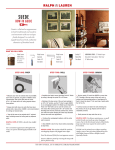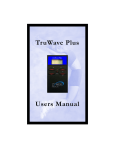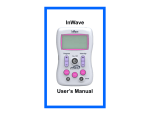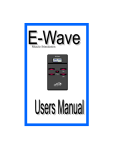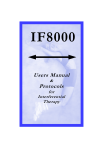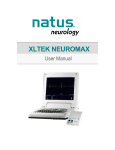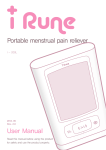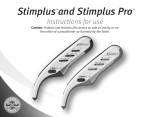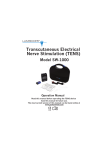Download User`s Manual - Zynex Medical, Inc.
Transcript
NexWave User’s Manual 1 NexWave Table of Contents Contact Information / Customer Service / Supplies / Support 4 About the NexWave5 Safety Information6 Electrodes and Lead Wires Setup9 Programming Instructions12 Preprogrammed Modes13 Controls15 Operating Instructions16 Protocols17 Indications, Contraindications and Warnings 31 Precautions and Adverse Reactions 40 Troubleshooting41 Specifications and Accessories42 Electrodes, Batteries, and Cleaning43 Warranty44 3 Zynex® Medical Contact Information CUSTOMER SERVICE866-940-7030 Supplies: To order more electrodes or other accessories Technical Support: Questions or problems with using your device Device Return: Order a postage paid return envelope to return your device at no charge MAIN OFFICE800-495-6670 303-703-4906 Billing Questions: Questions regarding insurance benefits and covered benefits for Durable Medical Equipment (DME) or questions about an Explanation of Benefits form you received in the mail. FAX NUMBER800-495-6695 303-347-9153 MAILING ADDRESS Zynex Medical, Inc. 9990 Park Meadows Drive Lone Tree, CO 80124-6739 USA [email protected] WEBSITEwww.zynex.com European Representative Zynex Europe Fælledvej 1, Box 19 BDO DK-5100 Odense C Denmark 4 0470 About the NexWave The NexWave is a multiple-mode stimulator which allows users a choice of treatment options. This device incorporates Interferential Current (IFC), Transcutaneous Electrical Nerve Stimulation (TENS), and Neuromuscular Electrical Stimulation (NMES). Interferential Current (IFC) The left channel (channel 1) produces a signal at a frequency of 4000 Hz. A slightly higher frequency (4001-4128 Hz) is produced by the right channel (channel 2). When applied to the skin, the signals from the two channels “interfere” with each other, and create a difference frequency which is felt during treatment. The skin is 100 times less resistant to electrical stimulation using this method. Consequently more of the stimulation energy reaches the nerve and muscle fibers and hence becomes more productive. With more stimulation reaching the affected area, IFC is recommended to be applied 3-4 times a day for 30-40 minutes per treatment. IFC therapy requires the use of both channels (four electrodes). Transcutaneous Electrical Nerve Stimulation (TENS) TENS delivers electrical impulses through the skin in the range of 1-125 Hz. TENS treatments can range from 10 minutes to many hours and can be applied as needed for pain relief. Patients can use one or two channels (two or four electrodes) for TENS therapy. Neuromuscular Electrical Stimulation (NMES) NMES delivers electrical impulses to muscular motor points at a frequency of 35 Hz. The output is set to a level which causes muscular contraction. These impulses are turned on for a period of 10 seconds, and turned off for a period of 10 seconds, 20 seconds, or 30 seconds. The outputs ramp up for 3 seconds, remain at the desired level for 10 seconds, ramp down for 1 second, and remain off for 10, 20, or 30 seconds. Recommended use is 3-4 times per day for 20-30 minutes per treatment. Patients can use one or two channels (two or four electrodes) for NMES therapy. Important: This device must be ordered or prescribed by a licensed physician. 5 Safety Information Equipment Classification As per the International Electrotechnical Commission standard IEC 60601-1, and the European standard EN 60601-1, Medical Electrical Equipment, General Requirements for Basic Safety and Essential Performance, the NexWave is classified as follows: · Type BF Equipment A Type BF piece of equipment is one that provides a particular degree of protection against electric shock, particularly regarding allowable leakage current. Type BF applied part is one that is floating above ground and is isolated from all other parts of the equipment. · Medical Device Directive (MDD) Classification The NexWave a Class IIa medical device per the European Medical Device Directive. · Internally Powered Equipment When the NexWave is powered by the internal, 9 VDC, MN1604, battery it is classified as Internally Powered Equipment. · Class II Medical Equipment When powered by the external, 12 VDC, medical grade, power supply, the NexWave is classified as Class II Medical Electrical (ME) Equipment. Note: When the external power supply is connected to the NexWave device, the power supply is considered part of the ME equipment. · Electromagnetic Compatibility Conforms to IEC 60601-1-2. · Temperature Operating temperature range: 0° - 40° C (32° - 104° F) Storage temperature range: -20° - 70° C (-4° - 158° F) · Water Ingress Ordinary equipment. This device does not have protection against ingress of water. · Flammable Anesthetics This device is not suitable for use in the presence of a flammable anesthetic mixture with air, or in the presence of a flammable anesthetic mixture with oxygen or nitrous oxide. 6 Safety Information Mode of Operation This device is suitable for continuous operation. Symbols Safety symbols shown on the device above are defined below. On/Off. This symbol indicates that the labeled switch electronically cycles the DC power on and off for part of the equipment. Note: To disconnect the external power supply, unplug the power cord of the supplied AC adapter from the AC mains outlet General Warning Sign. Follow warnings stated in the instruction manual to prevent potential hazards. Refer to Instruction Manual/Booklet. The operator must read, understand, and follow all instructions in the accompanying document including all warnings, cautions, and precautions before using this medical device. Type BF Equipment. This symbol indicates that the patient applied parts (electrodes) are Type BF (floating from ground) offering the user a specific level of safety. 7 Waste Electrical and Electronic Equipment (WEEE). This product may contain substances known to be hazardous to the environment or to human health. It should be disposed of properly (for example, at your local waste collection administration or recycling plant) and in accordance with local ordinances. Service and Calibration · Do not remove the cover. There are no user serviceable parts. Refer all service to authorized personnel. No modification of the equipment is allowed. · No preventative inspections are required. Factory testing and calibration ensure equipment accuracy and response. Contact Zynex Medical for factory re-calibration if necessary. 8 NexWave Electrode and Lead Wire Setup Step 1 Open electrode package and remove electrodes from package. Keep electrodes on plastic backing. Note: Only Zynex Medical electrodes are approved for use with the NexWave. P/N 300027 are provided standard. Sterile electrodes, P/N 300100, are optionally available (for U.S. only). See Accessories on page 42. Electrode Connector Plastic Backing Electrode Step 2 Insert lead wire pin connectors into electrode connectors as shown below. RED lead wire connectors on one side and BLACK lead-wire connectors on the other side. IFC modality requires all 4 electrodes (2 channels) TENS and NMES modalities can use 2 electrodes (1 channel) or 4 electrodes (2 channels) 9 NexWave Electrode and Lead Wire Setup (continued) Step 3 Remove each electrode from the plastic backing and place on the treatment site according to the type of modality selected. Electrode Arrangement When using the IFC modality, RED and BLACK lead wires must be placed in a crisscrossed pattern as shown in the diagram below. TENS or NMES shall not be crisscrossed and can be placed in a side-by-side pattern. IFC Crisscrossed Pattern 10 TENS or NMES Up and Down Pattern NexWave Electrode and Lead Wire Setup (continued) Step 4 Plug lead wires into the top of the device. The IFC modality requires both sets of lead wires to be connected (channel 1 and 2). TENS and NMES can use 1 set (Channel 1) or 2 sets (Channel 1 and 2) of lead wires. Step 5 Proceed to page 16 to start treatment or page 12 to program device. Channel 1 Channel 2 11 NexWave Device Programming Instructions Turn device on by pressing the black On/Standby button 1. Select desired Modality by pressing the “IFC”, “TENS”, or “NMES” button once. 2. Continue to press the selected modality button until arrow is next to desired program. 3. Press Treatment Timer button until desired treatment time is set on screen. Device is now ready to use. On / Off Button Modality Buttons Treatment Timer Button 12 NexWave Preprogrammed Modes Interferential Current (IFC) Mode Description Low-High The frequency of channel 2 sweeps between 4001 Hz and 4128 Hz every 15 seconds, while the channel 1 frequency remains fixed at 4000 Hz. Low The frequency of channel 2 sweeps between 4001 Hz and 4010 Hz every 15 seconds, while the channel 1 frequency remains fixed at 4000 Hz. Combo Combo consists of three 2 minute cycles which repeat over the duration of the treatment. 1st cycle - Low Mode: as described above. 2nd cycle - High Mode: like Low Mode, but channel 2 sweeps between 4064 Hz and 4128 Hz. 3rd cycle - Muscle Mode: The frequency of channel 2 is fixed at 4064 Hz, and the frequency of channel 1 is fixed at 4000 Hz. Both channels are cycled on and off simultaneously at 6 second intervals. Transcutaneous Electrical Nerve Stimulation (TENS) Mode Description Sweep The frequency is decreased linearly from 125 Hz to 11 Hz over a 4 second span. During this time, the pulse width is increased linearly from 120 µs to 300 µs. Then the frequency is decreased from 10 Hz to 1 Hz over a two second span. The pulse width is constant at 300 µs. Then the frequency is increased linearly from 11 Hz to 125 Hz over a four second span. During this time, the pulse width is decreased linearly from 300 µs to 120 µs. Lmd Frequency sweeps between 66.7-100 Hz and back again over 12 seconds. Pulse width linearly decreases to 150 µs when frequency is sweeping up and increases back up to the nominal pulse width of 300 µs when frequency is sweeping down. Hmd Same as Lmd, but with a frequency shift interval of 2 seconds. 13 Neuromuscular Electrical Stimulation (NMES) 14 Mode Description 30:10 Preset 10 seconds on and 30 seconds off time, 35 Hz frequency, 480 µs pulse width, 3 second ramp-up, 1 second ramp-down, both channels cycle simultaneously. 20:10 Same as above, but with 20 second off time. 10:10 Same as above, but with and 10 second off time. NexWave Device Controls Display Lead Wire Connection Channel 1 Lead Wire Connection Channel 2 Uses electricity from wall socket instead of 9 V battery A/C Adapter Input Turns Unit On/Off On/Off Button Channel 1 Intensity Control Channel 2 Intensity Control Up and Down Button Up and Down Button Unlock Button Controls IFC, TENS, NMES Unlock Button Modality Buttons Treatment Timer Treatment Timer Button 15 NexWave Device Operating Instructions Start Treatment: Before starting treatment electrodes must be placed on the treatment site and lead wires and electrodes connected to the device. See pages 9-11 and 17-30 for examples. 1. Turn NexWave on by pressing On/Standby button once 2. Increase intensity by pressing Channel 1 Up button until a strong but comfortable stimulation level is felt. Repeat for Channel 2 if both lead wires are attached and device is in TENS or NMES mode. 3. Once desired level of stimulation is set, the unit will automatically shut off at the preset treatment time shown on the display. If Treatment Timer has been set to No Timer then the device will need to be shut off manually. Refer to Programming Instructions on page 12 to adjust Treatment Timer. 4. To turn off device manually, press the On/Standby button. Note: Intensity level can be increased or decreased with either Channel 1 or Channel 2 Up and Down buttons when device is set to IFC Mode. If “Check Connections!” message is displayed on the screen, see “Display Alerts” below. During Treatment: IMPORTANT: Button controls lock after 20 seconds of inactivity. To unlock button controls, press Unlock button. Increase Intensity: To increase intensity press the Up Intensity button for either channel until the desired level of stimulation is felt. While in IFC mode, pressing either channel Up Intensity button will increase the stimulation level. Decrease Intensity: To decrease intensity press the Down Intensity button for each channel until desired level of stimulation is felt. While in IFC mode, pressing either channel Down Intensity button will decrease the stimulation level. Display Alerts: Check Connections: Lead wire(s) and/or electrode(s) may not be attached properly. Check all connections and try again (see page 41). If problem persists, call Technical Support (see page 4). Low Battery: Replace battery immediately or connect the A/C adapter. 16 Locked: Stimulation level and mode cannot be changed until Unlock button is pressed. Radicular Back Pain-Sciatica PAIN CONTROL INTENSITY LEVEL: The stimulation level should be set to a strong, but comfortable strength. DEVICE SET-UP: Modality Mode Treatment Time TENS Swp, Lmd, Hmd As needed ELECTRODE PLACEMENT Option 1 Electrodes should follow the dermatomal pattern related to the affected nerve root within the spinal segments involved. TENS Modality Place the electrodes with the RED and BLACK ends of the leadwires according to pattern depicted on figure to the left. ELECTRODE PLACEMENT Option 2 Electrodes should follow the dermatomal pattern related to the affected nerve root within the spinal segments involved. OVERLAPPING Techniques may vary. 17 Lumbar Back PAIN CONTROL INTENSITY LEVEL: The stimulation level should be set to a strong, but comfortable strength. DEVICE SET-UP: Modality Mode IFC LoHi, Low, Cmb TENS Swp, Lmd, Hmd NMES 30:10, 20:10, 10:10 off:on time Treatment Time 40 minutes 4 times/day As needed As needed ELECTRODE PLACEMENT Electrodes should surround the targeted treatment site with area of pain located in the center of the electrode area. IFC Modality Place the electrodes with the RED and BLACK ends of the leadwires according to pattern depicted on figure to the left. TENS / NMES Modality Place the electrodes with the RED and BLACK ends of the leadwires according to pattern depicted on figure to the left. Using both channels and crisscrossing the electrodes is optional when using the TENS or NMES modality. 18 Thoracic Back PAIN CONTROL INTENSITY LEVEL: The stimulation level should be set to a strong, but comfortable strength. DEVICE SET-UP: Modality Mode IFC LoHi, Low, Cmb TENS Swp, Lmd, Hmd NMES 30:10, 20:10, 10:10 off:on time Treatment Time 40 minutes 4 times/day As needed As needed ELECTRODE PLACEMENT Electrodes should surround the targeted treatment site with area of pain located in the center of the electrode area. IFC Modality Place the electrodes with the RED and BLACK ends of the leadwires according to pattern depicted on figure to the left. TENS / NMES Modality Place the electrodes with the RED and BLACK ends of the leadwires according to pattern depicted on figure to the left. Using both channels and crisscrossing the electrodes is optional when using the TENS or NMES modality. 19 Cervical / Upper Back PAIN CONTROL INTENSITY LEVEL: The stimulation level should be set to a strong, but comfortable strength. DEVICE SET-UP: Modality Mode IFC LoHi, Low, Cmb TENS Swp, Lmd, Hmd NMES 30:10, 20:10, 10:10 off:on time Treatment Time 40 minutes 4 times/day As needed As needed ELECTRODE PLACEMENT Electrodes should surround the targeted treatment site with area of pain located in the center of the electrode area. IFC Modality Place the electrodes with the RED and BLACK ends of the leadwires according to pattern depicted on figure to the left. TENS / NMES Modality Place the electrodes with the RED and BLACK ends of the leadwires according to pattern depicted on figure to the left. Using both channels and crisscrossing the electrodes is optional when using the TENS or NMES modality. 20 Shoulder PAIN CONTROL INTENSITY LEVEL: The stimulation level should be set to a strong, but comfortable strength. DEVICE SET-UP: Modality Mode IFC LoHi, Low, Cmb TENS Swp, Lmd, Hmd NMES 30:10, 20:10, 10:10 off:on time Treatment Time 40 minutes 4 times/day As needed As needed ELECTRODE PLACEMENT Electrodes should surround the targeted treatment site with area of pain located in the center of the electrode area. IFC Modality Place the electrodes with the RED and BLACK ends of the leadwires according to pattern depicted on figure to the left. TENS / NMES Modality Place the electrodes with the RED and BLACK ends of the leadwires according to pattern depicted on figure to the left. Using both channels and crisscrossing the electrodes is optional when using the TENS or NMES modality. 21 Elbow PAIN CONTROL INTENSITY LEVEL: The stimulation level should be set to a strong, but comfortable strength. DEVICE SET-UP: Modality Mode Treatment Time IFC TENS LoHi, Low, Cmb Swp, Lmd, Hmd 40 minutes 4 times/day As needed ELECTRODE PLACEMENT Electrodes should surround the targeted treatment site with area of pain located in the center of the electrode area. IFC Modality Place the electrodes with the RED and BLACK ends of the leadwires according to pattern depicted on figure below. Dorsal View same arm Palmar View same arm TENS Modality Place the electrodes with the RED and BLACK ends of the leadwires according to pattern depicted on figure below. Using both channels and crisscrossing the electrodes is optional when using the TENS or NMES modality. Dorsal View same arm Palmar View same arm 22 Wrist PAIN CONTROL INTENSITY LEVEL: The stimulation level should be set to a strong, but comfortable strength. DEVICE SET-UP: Modality Mode Treatment Time IFC TENS LoHi, Low, Cmb Swp, Lmd, Hmd 40 minutes 4 times/day As needed ELECTRODE PLACEMENT Electrodes should surround the targeted treatment site with area of pain located in the center of the electrode area. IFC Modality Place the electrodes with the RED and BLACK ends of the leadwires according to pattern depicted on figure below. Palmar View Dorsal View same arm same arm TENS Modality Place the electrodes with the RED and BLACK ends of the leadwires according to pattern depicted on figure below. Using both channels and crisscrossing the electrodes is optional when using the TENS or NMES modality. Palmar View same arm Dorsal View same arm 23 Hip PAIN CONTROL INTENSITY LEVEL: The stimulation level should be set to a strong, but comfortable strength. DEVICE SET-UP: Modality Mode IFC LoHi, Low, Cmb TENS Swp, Lmd, Hmd NMES 30:10, 20:10, 10:10 off:on time Treatment Time 40 minutes 4 times/day As needed As needed ELECTRODE PLACEMENT Electrodes should surround the targeted treatment site with area of pain located in the center of the electrode area. IFC Modality Place the electrodes with the RED and BLACK ends of the leadwires according to pattern depicted on figure to the left. TENS / NMES Modality Place the electrodes with the RED and BLACK ends of the leadwires according to pattern depicted on figure to the left. Using both channels and crisscrossing the electrodes is optional when using the TENS or NMES modality. 24 Back of Leg PAIN CONTROL INTENSITY LEVEL: The stimulation level should be set to a strong, but comfortable strength. DEVICE SET-UP: Modality Mode IFC LoHi, Low, Cmb TENS Swp, Lmd, Hmd NMES 30:10, 20:10, 10:10 off:on time Treatment Time 40 minutes 4 times/day As needed As needed ELECTRODE PLACEMENT Electrodes should surround the targeted treatment site with area of pain located in the center of the electrode area. IFC Modality Place the electrodes with the RED and BLACK ends of the leadwires according to pattern depicted on figure to the left. TENS / NMES Modality Place the electrodes with the RED and BLACK ends of the leadwires according to pattern depicted on figure to the left. Using both channels and crisscrossing the electrodes is optional when using the TENS or NMES modality. 25 Anterior Knee PAIN CONTROL INTENSITY LEVEL: The stimulation level should be set to a strong, but comfortable strength. DEVICE SET-UP: Modality Mode IFC LoHi, Low, Cmb TENS Swp, Lmd, Hmd NMES 30:10, 20:10, 10:10 off:on time Treatment Time 40 minutes 4 times/day As needed As needed ELECTRODE PLACEMENT Electrodes should surround the targeted treatment site with area of pain located in the center of the electrode area. IFC Modality Place the electrodes with the RED and BLACK ends of the leadwires according to pattern depicted on figure to the left. TENS / NMES Modality Place the electrodes with the RED and BLACK ends of the leadwires according to pattern depicted on figure to the left. Using both channels and crisscrossing the electrodes is optional when using the TENS or NMES modality. 26 Lateral / Medial Knee PAIN CONTROL INTENSITY LEVEL: The stimulation level should be set to a strong, but comfortable strength. DEVICE SET-UP: Modality Mode IFC LoHi, Low, Cmb TENS Swp, Lmd, Hmd NMES 30:10, 20:10, 10:10 off:on time Treatment Time 40 minutes 4 times/day As needed As needed ELECTRODE PLACEMENT Electrodes should surround the targeted treatment site with area of pain located in the center of the electrode area. IFC Modality Place the electrodes with the RED and BLACK ends of the leadwires according to pattern depicted on figure to the left. Inside View Same Leg Outside TENS / NMES Modality Place the electrodes with the RED and BLACK ends of the leadwires according to pattern depicted on figure to the left. Inside View Same Leg Outside Using both channels and crisscrossing the electrodes is optional when using the TENS or NMES modality. 27 Ankle PAIN CONTROL INTENSITY LEVEL: The stimulation level should be set to a strong, but comfortable strength. DEVICE SET-UP: Modality Mode Treatment Time IFC TENS LoHi, Low, Cmb Swp, Lmd, Hmd 40 minutes 4 times/day As needed ELECTRODE PLACEMENT Electrodes should surround the targeted treatment site with area of pain located in the center of the electrode area. IFC Modality Place the electrodes with the RED and BLACK ends of the leadwires according to pattern depicted on figure to the left. ACHILLES TENDON 28 TENS / NMES Modality Place the electrodes with the RED and BLACK ends of the leadwires according to pattern depicted on figure to the left. Using both channels and crisscrossing the electrodes is optional when using the TENS or NMES modality. ACHILLES TENDON Inside View Same Foot Outside View Same Foot Inside View Same Foot Outside View Same Foot Inside View Same Foot Outside View Same Foot Inside View Same Foot Outside View Same Foot Foot PAIN CONTROL INTENSITY LEVEL: The stimulation level should be set to a strong, but comfortable strength. DEVICE SET-UP: Modality Mode Treatment Time IFC TENS LoHi, Low, Cmb Swp, Lmd, Hmd 40 minutes 4 times/day As needed ELECTRODE PLACEMENT Electrodes should surround the targeted treatment site with area of pain located in the center of the electrode area. IFC Modality Place the electrodes with the RED and BLACK ends of the leadwires according to pattern depicted on figure to the left. TENS / NMES Modality Place the electrodes with the RED and BLACK ends of the leadwires according to pattern depicted on figure to the left. Using both channels and crisscrossing the electrodes is optional when using the TENS or NMES modality. 29 Post-Operative Knee PAIN RELIEF & EDEMA REDUCTION Post-operative pain and swelling may be reduced by the application of electrical stimulation immediately after surgery and continuing as needed. INTENSITY LEVEL: The stimulation level should be set to a strong, but comfortable strength. DEVICE SET-UP: Modality Mode Treatment Time IFC TENS TENS Cmb Swp Lmd or Hmd 40 minutes 4 times/day As needed for pain & swelling As needed for pain & swelling ELECTRODE PLACEMENT When applying electrodes in the operating room, sterile electrodes must be used and placed away from incisions as shown below. Electrodes applied outside the operating room do not need to be sterile and should be placed around the bandaged area in the pattern shown below. Electrodes should surround the targeted treatment site with area of pain located in the center of the electrode area. IFC Modality Place the electrodes with the RED and BLACK ends of the leadwires according to pattern depicted on figure to the left. TENS / NMES Modality Place the electrodes with the RED and BLACK ends of the leadwires according to pattern depicted on figure to the left. Crisscrossing the electrodes is optional when using the TENS Waveform. 30 Protocol based on the following study: The Effects of Home Interferential Therapy on Post-Operative Pain, Edema, and Range of Motion of the Knee, by Gregg J. Jarit, MD, Karen J. Mohr, PT, SCS, Robert Waller, BS and Ronald E. Glousman, MD Published in Clinical Journal of Sports Medicine, 13:16-20 © 2003 Lippincott Williams & Wilkins, Inc, Philadelphia Muscle Spasm SPASM REDUCTION Muscle spasm may be reduced by intentionally fatiguing the associated muscle or muscle group. INTENSITY LEVEL: The stimulation level should be set to a strong, but comfortable strength. DEVICE SET-UP: Modality Mode Treatment Time IFC NMES Cmb 10:10 off:on time 40 minutes 3 to 4 times/day 40 minutes 3 to 4 times/day ELECTRODE PLACEMENT Electrodes should surround the targeted treatment site with area of pain located in the center of the electrode area. IFC Modality Place the electrodes with the RED and BLACK ends of the leadwires according to pattern depicted on figure to the left. NMES Modality Place the electrodes with the RED and BLACK ends of the leadwires according to pattern depicted on figure to the left. 31 NexWave Indications for Use Indications · · Interferential Current (IFC) Management and symptomatic relief of chronic intractable, posttraumatic and post-surgical pain. This stimulator should only be used under supervision for adjunctive therapy for the treatment of medical diseases and conditions. Contraindications · · · This stimulator should not be used on patients with a cardiac demand pacemaker. Electrodes should not be placed so that current will be applied to the carotid sinus (neck) region or transcerebrally (through the head). This stimulator should not be used whenever pain syndromes are undiagnosed until etiology is established. Warnings · · · When using the separate external power supply, this medical electrical device does not incorporate a power switch to isolate the system from the AC mains. Unplug the power cord of the AC adapter from the AC mains outlet in order to positively disconnect from the AC mains. Ensure that the AC outlet is easily accessible. The device is capable of generating current densities for electrodes exceeding 2 mA RMS/cm2 which may require special attention of the operator. Do not exceed 0.5 W/cm2 with recommended electrodes, assuming a load of 1000 Ω. · 1” round: Maximum stimulation setting = 50 mA · 2” round: Maximum stimulation setting = 50 mA · 2” square: Maximum stimulation setting = 50 mA · 32 Output waveform/power information: When delivering stimulation energy, the NexWave in IFC mode is a constant current output device. Therefore its output voltage, current, and power are dependent upon the load as well as the pulse width and frequency of the output waveform. Using the supplied AC adapter to power the unit, the maximum peak voltage that the NexWave can produce is 50 V (1000 Ω load). The maximum peak current that the NexWave can produce is 50 mA (1000 Ω load). The maximum output power that the NexWave can produce is 2.5 W per channel into a 1000 Ω load, 5 W total. NexWave Warnings Interferential Current (IFC) Warnings (Continued) · Maximum peak output voltage (500 Ω load) = 25 V · Maximum peak output current (500 Ω load) = 50 mA · Maximum peak output voltage (1 KΩ load) = 50 V · Maximum peak output current (1 KΩ load) = 50 mA · Maximum peak output voltage (2 KΩ load) = 50 V · Maximum peak output current (2 KΩ load) = 25 mA · Frequency: 4000 Hz nominal · Duty Cycle: 100% · Maximum RMS voltage (500 Ω load) = 25 V · Maximum RMS current (500 Ω load) = 50 mA · Maximum output power (500 Ω load) = 1.25 W per channel · Maximum RMS voltage (1 KΩ load) = 50 V · Maximum RMS current (1 KΩ load) = 50 mA · Maximum output power (1 KΩ load) = 2.5 W per channel · Maximum RMS voltage (2 KΩ load) = 50 V · Maximum RMS current (2 KΩ load) = 25 mA · Maximum output power (2 KΩ load) = 1.25 W per channel · The safety of Interferential devices for use during pregnancy or birth has not been established. · This device is not effective for pain of central origin. (This includes headache.) · This device should only be used under the continued supervision of a trained physician. · This device does not have curative value. · This device offers symptomatic treatment such as suppressing the sensation of pain which would otherwise serve as a protective mechanism. · The user must keep the device out of the reach of children. · Electronic monitoring equipment (such as ECG monitors and ECG alarms) may not operate properly when this device is in use. · The long-term effects of chronic electrical stimulation are unknown. · Stimulation should not be applied over the carotid sinus nerves, particularly in patients with known sensitivity to the carotid sinus reflex. · Stimulation should not be applied over the neck or mouth. Severe spasm of the laryngeal and pharyngeal muscles may occur and the contractions may be strong enough to close the airway or cause difficulty in breathing. · Stimulation should not be applied transthoracically in that the introduction of electrical current into the heart may cause cardiac arrhythmias. 33 NexWave Warnings Interferential Current (IFC) Warnings (Continued) · · · · · · Stimulation should not be applied transcerebrally. Stimulation should not be applied over swollen, infected, or inflamed areas of skin eruptions, e.g. phlebitis, thrombophlebitis, varicose veins, etc. Stimulation should not be applied over, or in proximity to, cancerous lesions. The device is capable of generating currents and voltages in excess of 10 mA RMS and 10 V RMS, respectively. A yellow LED indicator is provided next to each lead wire connector to show that the unit is delivering energy for any non-zero value of stimulation output (1-50 mA). Simultaneous connection of a patient to high frequency surgical equipment may result in burns at the site of the stimulator electrodes and possible damage to the stimulator. Operations within close proximity (within one meter) of shortwave or microwave therapy equipment may produce instability in the stimulation output. Safety References Zynex® Medical, Inc. is only responsible for the safety, reliability and function of the device when repairs and adjustments have been made by persons authorized by Zynex® Medical, Inc., and the device is used in accordance with the user’s manual. Repairs and technical safety tests shall only be performed by authorized personnel. 34 NexWave Indications for Use Transcutaneous Electrical Nerve Stimulation (TENS) Indications · · Management and symptomatic relief of chronic intractable, posttraumatic and post-surgical pain. This stimulator should only be used under supervision for adjunctive therapy for the treatment of medical diseases and conditions. Contraindications · · · This stimulator should not be used on patients with a cardiac demand pacemaker. Electrodes should not be placed so that current will be applied to the carotid sinus (neck) region or transcerebrally (through the head). This stimulator should not be used whenever pain syndromes are undiagnosed until etiology is established. Warnings · · · · When using the separate external power supply, this medical electrical device does not incorporate a power switch to isolate the system from the AC mains. Unplug the power cord of the AC adapter from the AC mains outlet in order to positively disconnect from the AC mains. Ensure that the AC outlet is easily is accessible. The device is capable of generating current densities for electrodes exceeding 2 mA RMS/cm2 which may require special attention of the operator. Do not exceed 0.5 W/cm2 with recommended electrodes, assuming a load of 1000 Ω. · 1” round: Maximum stimulation setting = 100 mA · 2” round: Maximum stimulation setting = 100 mA · 2” square: Maximum stimulation setting = 100 mA Output waveform/power information: When delivering stimulation energy, the NexWave in TENS mode is a constant current output device. Therefore its output voltage, current, and power are dependent upon the load as well as the pulse width and frequency of the output waveform. The maximum peak voltage that the NexWave can produce is 100 V (1000 Ω load). The maximum peak current that the NexWave can produce is 100 mA (1000 Ω load). The maximum output power that the NexWave can produce is 0.15 W per channel into 1000 Ω load, 0.30 W total. 35 NexWave Warnings Transcutaneous Electrical Nerve Stimulation (TENS) Warnings (Continued) · Maximum peak output voltage (500 Ω load) = 50 V · Maximum peak output current (500 Ω load) = 100 mA · Maximum peak output voltage (1 KΩ load) = 100 V · Maximum peak output current (1 KΩ load) = 100 mA · Maximum peak output voltage (2 KΩ load) = 100 V · Maximum peak output current (2 KΩ load) = 50 mA · Pulse width range: 120 - 300 µs · Pulse frequency range: 1 - 125 Hz · Maximum RMS voltage (500 Ω load) = 7.07 V · Maximum RMS current (500 Ω load) = 14.14 mA · Maximum output power (500 Ω load) = 0.10 W per channel · Maximum RMS voltage (1 KΩ load) = 14.14 V · Maximum RMS current (1 KΩ load) = 14.14 mA · Maximum output power (1 KΩ load) = 0.20 W per channel · Maximum RMS voltage (2 KΩ load) = 14.14 V · Maximum RMS current (2 KΩ load) = 7.07 mA · Maximum output power (2 KΩ load) = 0.10 W per channel · The safety of TENS devices for use during pregnancy or birth has not been established. · This device is not effective for pain of central origin. (This includes headache.) · This device should only be used under the continued supervision of a physician. · This device does not have curative value. · This device offers symptomatic treatment such as suppressing the sensation of pain which would otherwise serve as a protective mechanism. · The user must keep the device out of the reach of children. · Electronic monitoring equipment (such as ECG monitors and ECG alarms) may not operate properly when this device is in use. · The long-term effects of chronic electrical stimulation are unknown. · Stimulation should not be applied over the carotid sinus nerves, particularly in patients with known sensitivity to the carotid sinus reflex. · Stimulation should not be applied over the neck or mouth. Severe spasm of the laryngeal and pharyngeal muscles may occur and the contractions may be strong enough to close the airway or cause difficulty in breathing. 36 NexWave Warnings Transcutaneous Electrical Nerve Stimulation (TENS) Warnings (Continued) · Stimulation should not be applied transthoracically in that the introduction of electrical current into the heart may cause cardiac arrhythmias. · Stimulation should not be applied transcerebrally. · Stimulation should not be applied over swollen, infected, or inflamed areas of skin eruptions, e.g. phlebitis, thrombophlebitis, varicose veins, etc. Stimulation should not be applied over, or in proximity to, cancerous · lesions. The device is capable of generating currents and voltages in excess of 10 mA RMS and 10 V RMS, respectively. A yellow LED indicator is provided next to each lead wire connector to show that the unit is delivering energy for any non-zero value of stimulation output (1-100 mA). Simultaneous connection of a patient to high frequency surgical equip· ment may result in burns at the site of the stimulator electrodes and possible damage to the stimulator. Operations within close proximity (within one meter) of shortwave or mi· crowave therapy equipment may produce instability in the stimulation output. Safety References Zynex® Medical, Inc. is only responsible for the safety, reliability and function of the device when repairs and adjustments have been made by persons authorized by Zynex® Medical, Inc., and the device is used in accordance with the user’s manual. Repairs and technical safety tests shall only be performed by authorized personnel. 37 NexWave Indications for Use Transcutaneous Electrical Nerve Stimulation (TENS) Indications · · · · · · Muscle re-education Prevention or retardation of disuse atrophy Increasing local blood circulation Maintaining or increasing range of motion Relaxation of muscle spasms This stimulator should only be used under supervision for adjunctive therapy for the treatment of medical diseases and conditions. Contraindications · This stimulator should not be used on patients with a cardiac demand pacemaker. · Electrodes should not be placed so that current will be applied to the carotid sinus (neck) region or transcerebrally (through the head). · This stimulator should not be used whenever pain syndromes are undiagnosed until etiology is established. Warnings 38 · When using the separate external power supply, this medical electrical device does not incorporate a power switch to isolate the system from the AC mains. Unplug the power cord of the AC adapter from the AC mains outlet in order to positively disconnect from the AC mains. Ensure that the AC outlet is easily accessible. · The device is capable of generating current densities for electrodes exceeding 2 mA rms/cm2 which may require special attention of the operator. · Do not exceed 0.5 W/cm2 with recommended electrodes, assuming a load of 1000 Ω. · 1” round: Maximum stimulation setting = 100 mA · 2” round: Maximum stimulation setting = 100 mA · 2” square: Maximum stimulation setting = 100 mA · Output waveform/power information: When delivering stimulation energy, the NexWave in NMES mode is a constant current output device. Therefore its output voltage, current, and power are dependent upon the load as well as the pulse width and frequency of the output waveform. The maximum peak voltage that the NexWave can produce is 100 V (1000 Ω load). NexWave Warnings Neuromuscular Electrical Stimulation (NMES) Warnings (Continued) The maximum output power that the NexWave can produce is 0.168 W per channel into a 1000 Ω load, 0.336 W total. · Maximum peak output voltage (500 Ω load) = 50 V · Maximum peak output current (500 Ω load) = 100 mA · Maximum peak output voltage (1 KΩ load) = 100 V · Maximum peak output current (1 KΩ load) = 100 mA · Maximum peak output voltage (2 KΩ load) = 100 V · Maximum peak output current (2 KΩ load) = 50 mA · Pulse width range: 480 µs · Pulse frequency range: 35 Hz · Maximum RMS voltage (500 Ω load) = 6.48 V · Maximum RMS current (500 Ω load) = 12.96 mA · Maximum output power (500 Ω load) = 0.084 W per channel · Maximum RMS voltage (1 KΩ load) = 12.96 V · Maximum RMS current (1 KΩ load) = 12.96 mA · Maximum output power (1 KΩ load) = 0.168 W per channel · Maximum RMS voltage (2 KΩ load) = 12.96 V · Maximum RMS current (2 KΩ load) = 6.48 mA · Maximum output power (2 KΩ load) = 0.084 W per channel · The safety of NMES devices for use during pregnancy or birth has not been established. · This device is not effective for pain of central origin. (This includes headache.) · This device should only be used under the continued supervision of a physician. · This device does not have curative value. · This device offers symptomatic treatment such as suppressing the sensation of pain which would otherwise serve as a protective mechanism. · The user must keep the device out of the reach of children. · Electronic monitoring equipment (such as ECG monitors and ECG alarms) may not operate properly when this device is in use. · The long-term effects of chronic electrical stimulation are unknown. · Stimulation should not be applied over the carotid sinus nerves, particularly in patients with known sensitivity to the carotid sinus reflex. 39 NexWave Warnings Neuromuscular Electrical Stimulation (NMES) Warnings (Continued) · Stimulation should not be applied over the neck or mouth. Severe spasm of the laryngeal and pharyngeal muscles may occur and the contractions may be strong enough to close the airway or cause difficulty in breathing. · Stimulation should not be applied transthoracically in that the introduction of electrical current into the heart may cause cardiac arrhythmias. · Stimulation should not be applied transcerebrally. · Stimulation should not be applied over swollen, infected, or inflamed areas of skin eruptions, e.g. phlebitis, thrombophlebitis, varicose veins, etc. · Stimulation should not be applied over, or in proximity to, cancerous lesions. · The device is capable of generating currents and voltages in excess of 10 mA RMS and 10 V RMS, respectively. A yellow LED indicator is provided next to each lead wire connector to show that the unit is delivering energy for any non-zero value of stimulation output (1-100 mA). · Simultaneous connection of a patient to high frequency surgical equipment may result in burns at the site of the stimulator electrodes and possible damage to the stimulator. · Operations within close proximity (within one meter) of shortwave or microwave therapy equipment may produce instability in the stimulation output. Safety References Zynex® Medical, Inc. is only responsible for the safety, reliability and function of the device when repairs and adjustments have been made by persons authorized by Zynex® Medical, Inc., and the device is used in accordance with the user’s manual. Repairs and technical safety tests shall only be performed by authorized personnel. 40 NexWave Precautions and Adverse Reactions All Modes (IFC, TENS, NMES) Precautions · Isolated cases of skin irritation may occur at the site of the electrode placement following long-term application. · Effectiveness is highly dependent upon patient selection by a person qualified in management of pain patients. · Safety of powered muscle stimulators for use during pregnancy has not been established. · Caution should be used for patients with suspected or diagnosed heart problems. · Caution should be used for patients with suspected or diagnosed epilepsy. · Caution should be used in the presence of the following: 1. When there is a tendency to hemorrhage following acute trauma or fracture. 2. Following recent surgical procedures when muscle contraction may disrupt the healing process. 3. Over the menstruating or pregnant uterus 4. Over the areas of the skin which lack normal sensation. · Some patients may experience skin irritation or hypersensitivity due to the electrical stimulation or electrical conductive medium. The irritation can usually be reduced by using an alternate conductive medium, or alternate electrode placement. · Electrode placement and stimulation settings should be based on the guidance of the prescribing physician. · This device should be kept out of reach of children. · This device should be used only with the leads and electrodes recommended for use by the manufacturer. · This device should not be used while driving, operating machinery, or during any activity in which voluntary muscle contractions may put the user at undue risk of injury. Adverse Reactions · Skin irritation and burns beneath the electrodes are potential adverse reactions. 41 Troubleshooting Problem 42 Solution Unit stays on even after treatment ends. Hold Off button down for 2 seconds to shut unit off. Otherwise unit will shut off automatically after 5 minutes of no stimulation. Alternatively you can start a new treatment session after the last one ends. Cannot increase level from its current set-ting. Press and release Unlock button or turn level down 1 mA to unlock this safety feature. Then increase stimulation to the desired level/intensity. Intensity level is always locked after 20 seconds of key press inactivity. Do not feel the IF beating frequency in the center of the four electrodes. Check that the lead wires are connected correctly to the electrodes (red opposite to each other, black opposite to each other) Display shows “Check Connections” (elec-trode alarm). Check electrode skin contact. Electrodes should be fresh and stick well. Use water if necessary to soften the gel for better contact. Verify that all four electrodes are connected to lead wires and that both lead wires are connected to the unit. Connect the bare metal pins together to shortcircuit the outputs. If the electrode alarm ceases the problem is with the electrode connection integrity. NexWave Specifications and Accessories Interferential Current (IFC) Amplitude:0-50 mA Channel 1 frequency: 4000 Hz Channel 2 frequency: 4001- 4128 Hz I/F Modes:Low-High, Low, Combo Muscle Mode: 64 Hz, 6 sec. on, 6 sec. off, ramp up 1 sec., and ramp down 0.5 sec. Waveforms:Symmetrical biphasic Transcutaneous Electrical Nerve Stimulation (TENS) Amplitude:0-100 mA Frequency:1-125 Hz Pulse Width:120-300 µs TENS Modes: Sweep, Low Modulated, High Modulated Waveform:Symmetrical biphasic Neuromuscular Electrical Stimulation (NMES) Amplitude:0-100 mA Frequency:35 Hz Pulse Width:480 µs NMES Modes: 30:10, 20:10, 10:10 On-Time:10 sec. Off-Time: 30, 20, or 10 sec. Ramp Up:3 sec. Ramp Down:1 sec. Waveforms:Symmetrical biphasic Other Specifications Treatment timer: 10 to 90 minutes, in 10 minute increments, with no timer setting. Compliance meter: Records total usage time in minutes and number of times used. Dimensions: 2.9 x 4.6 x 1.0 in. Weight:5.8 oz. including battery. Warranty: 5 year manufacturer’s warranty on materials and workmanship. Accessories excluded. Accessories Lead wires: 104203, lead wire, black, with black pins. 104204, lead wire, gray, with red pins. Electrodes: 300027, electrodes, 2” diameter, round, pkg. of four. 00, electrodes, sterile, 2” x 2”, square, pkg. of four. Power supply: 200112, power supply, medical grade, input 100-240 VAC, 50-60 Hz, 0.5 A max., output 12 VDC, 1.25 A max. Battery: 130010, battery, 9 V, alkaline, MN1604. 43 NexWave Electrodes, Batteries, and Cleaning Electrodes and Skin Care Proper skin care will help make the use of this device more comfortable and trouble-free. Prior to treatment, wash the areas where the electrodes will be placed with mild soap and water and rinse and dry the skin thoroughly. If necessary, remove excess body hair. Proper skin care will help make the use of this device more comfortable and trouble-free. Prior to treatment, wash the areas where the electrodes will be placed with mild soap and water and rinse and dry the skin thoroughly. If necessary, remove excess body hair. Sterile electrodes may be required for some post-operative applications. Follow directions of the prescribing physician. Battery Power One 9 V alkaline battery is used. The battery compartment on the back of the device opens by sliding the cover downwards. Rechargeable batteries are not recommended since they have only a short usage time and are not charged while in the device. Battery replacement is indicated by the battery icon in the display. Replace with a new 9 V alkaline battery. The NexWave operates normally even if the 9 V battery is inserted with reverse polarity. Please dispose of used batteries properly. AC Adapter The NexWave is supplied with an AC adapter that is plugged into the left side of the device and then into a 120 or 230 VAC electrical outlet. Note: The supplied AC adapter, Zynex® P/N 200112, mains power requirement is 100-240 VAC, 50-60 Hz, 0.5 A maximum. While plugged in, the device is powered from the electrical outlet and not the 9 V battery. The battery does not need to be removed while utilizing the AC adapter. Device Cleaning The NexWave case and display window can be cleaned by lightly applying mild soap to a damp soft cloth or paper towel and using it to wipe the surfaces clean. Allow the unit to dry thoroughly before using. Do not spray cleaning solutions directly onto the unit, or immerse it in water or other liquids. 44 NexWave Warranty Information The NexWave device is warranted to be free from defects in material, workmanship, and structural integrity when subjected to normal domestic use and service for five years after the original purchase. During that time, Zynex® Medical, Inc will repair or replace, at its sole discretion, the NexWave device that has been used in a standard manner. This warranty does not cover misuse or use contrary to the operating instructions supplied. Warranty obligations are limited to replacement or repair of defective parts and components, at the option of Zynex® Medical, Inc. This Warranty is only valid for the original purchaser of this product and will not be honored if the product ownership is transferred or is resold. To obtain warranty service, please contact Technical Support at the number listed on page 2 of this manual. 45 Zynex Medical, Inc. 9990 Park Meadows Dr. Lone Tree, CO 80124 USA Phone:800-495-6670 303-703-4906 Fax:800-495-6695 303-347-9153 Website: www.zynex.com Email: [email protected] European Representative: Zynex Europe Fælledvej 1, Box 19 BDO DK-5100 Odense C Denmark 300400, Rev.07, 10/15/2012 48













































